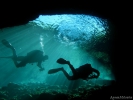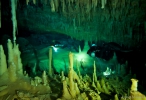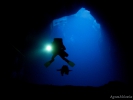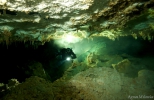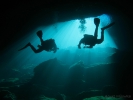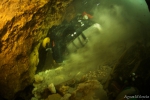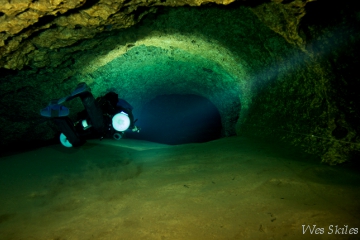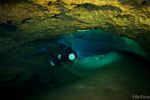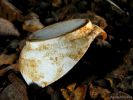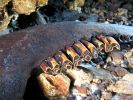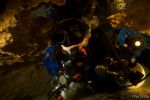Baptizing Spring Exploration |
 |
 |
|
I started off like any other tourist cave diver; diving all the big caves, thinking Florida is all about crystal clear springs, big tunnels and that is has long ago been tapped out... as it turned out I was wrong on all accounts. I found myself searching for caves further afield and this led me to many off-the-beaten-track sidemount caves out in the middle of the woods. Baptizing Spring was one of those caves. It has never got much traffic or interest from the hordes, as it is only a few hundred feet long. It is just as well that in my book, any cave is a good cave and I decided to go and check it out. Baptizing Spring has an upstream and downstream section and the exploration of each is a completely different story. So first let’s go with the flow and head downstream. No one has managed to negotiate the downstream section before and my buddy, James Toland and I were keen to check it out. James went in first with an 80cf tank and not much else but had no luck getting through. He looked at me and asked, ‘so do you want to have a go?’ No need to twist my arm, so down I went. At first glance the crack looked impassable, not even big enough to fit a tank through, let alone a person. However, on closer inspection I realized that to the right was a low flattener. I rearranged a few loose rocks and had a go at pushing through. Next thing I know - POW – I was in! So I tied off the reel and off I went down the passage. At this point I had no BC, no fins… a tank and a light in one hand and a reel in the other. I was roof walking for about 12m (40ft) and then I reached a big pit. That’s when I thought, this puppy goes! I tied off the reel and made my way back to get some proper gear and my buddy. I popped out of the water and was so stupidly excited I could hardly get a full sentence together. The gist of the babble was - grab your gear we’re going diving! I had to push the 95s in front of me to get in there, which was no surprise. But then I had an interesting predicament… I could not fit with the Nomad on. The harness came off, I was real happy about the quick release buckles let me tell you, and then all the gear got stuffed down the hole. As I was dressing myself on the other side of the restriction, it became apparent that my buddy was struggling to get in. He eventually waved me off, so I set off down the passage, picked up the reel and descended down the pit. It is difficult to describe the burst of energy and pure adrenalin that I was feeling at this time. It was all I could do to settle down the pounding heart and calmly tie off along the way. Nothing can beat the moment you unwind a reel into completely new and unchartered territory. One feels pure, unadulterated joy and happiness, all peppered with a bit of a thrill. While I had laid a bit of line here and there, further in and deeper down, typically I was just tagging along on other people’s projects. This time it was different. In the end I laid 200m (660ft) of line and had to work for every inch. The entrance restriction is just the beginning. The whole place was choked up with sand so the going was tough; a few of the restrictions took a significant amount of time to negotiate. As the downstream is a siphon this meant that the vis in front of me was non existent. Several times I had to stop and chill for a while, hoping the vis will clear enough for me to see which way was onward, after I had wedged myself into dead end corners and crevices. As it turned out James did follow me in eventually, he squeezed in with no gear and just the single tank, keen to have a look. But as he put it, I had redefined a restriction; he had to breathe out to get through the tight stuff. Needless to say, the process of removing gear and pushing it back up the hole was repeated on the way out and a celebratory drink followed. It was certainly an exciting discovery, to be able to push through the tightest of restrictions. Yet, it was the upstream section of the cave that is the leading lady of this story. The upstream section had been on my list of places to visit for a while, and finally X-mas day I decided to do just that. By all accounts there was only about 100m (330ft) of passage, but I heard it was a pretty little cave. Well, imagine my surprise when I got to the end of the line and saw that whilst the line stopped, the cave clearly didn’t. So I tied off a reel and spooled out. At first it was hard yakka, very low passage, filled with sand and then muddy clay. There is a good 300m (1000ft) of wriggling, in between a rock and a hard place; the restriction is unrelenting. Yet I pushed it, I persevered, I believed… and more to the point I fit! Eventually the cave opened up a little… then it opened up some more. My third day there I was swimming in quite a sizeable passage. It is here that I experienced the most awful of moments, the line on my reel ended, and yet the big cobalt blue passage ahead of me kept going. I dreamt about that passage that night and what could potentially be around the corner. Determined not to experience this disappointment again, the next day I took in two reels. Well, it seems not even that was enough. I kept going back, day after day for two weeks and each day unceremoniously dumped reel after reel into the cave and yet it just didn’t end. In a couple of weeks I laid over 1.8km (6000ft) of line, it was incredible. Those two weeks were amongst the best of my life, where I did very little other then sleep, eat, knot line and explore. I was keen to keep the discovery under wraps, given that in cave country secrets are hard to keep. I feared people could tell by the stupid and unrelenting grin on my face that something was up; either I was getting laid every hour on the hour or I was laying line in a virgin cave. Spending several hours a day at Wayne’s (Amigos Dive Center) knotting line could also have given folks a bit of a hint. I feel extremely lucky to have gotten the opportunity to discover it all piece by piece without anyone breathing down my neck. Finally at the end of the two weeks I realized I had to stop and survey. This was a difficult decision as the allure of seeing more unexplored cave was great. Yet it had to be done, since as they say, if you don’t survey you haven’t really done it. So I figured out what the DADs (Depth, Azimuth, Distance) where all about and sunk my teeth into it. Soon the thrill of pursuing virgin passage left me and I tackled creating the map with the same zeal as the initial exploration. I wanted and needed to see where the cave was heading. Laying line for the sake of laying line is not all it is cracked up to be, and the decision to stop to survey the joint was the best one I could have taken. The more time I spent in the cave the more I realized that I was having an impact and I began to struggle with an ethical and moral dilemma in regards to my presence. Seeing the cave in a pure, untouched state… and seeing the impact, however small, that I was having was daunting. While it is a phenomenal feeling to reach a place no other human has ever seen before, ones very presence robs it of its virginity and it will never be the same again. In the end it was the completed survey that helped to ease my inner demons, as the information gained in regards to the extent and layout of the cave has proved to be useful to the management of the area. It confirms that the State made the correct decision in regards to the acquisition and protection of the land. Further the discovery illustrates rather neatly that while not every spring is easily accessible, some are too small even for me to squeeze into, nonetheless they are there and chances are they lead to long and extensive cave systems. This means that everyone, cave diver and layman alike should be environmentally aware and think about the Floridian aquifer during their day to day activities. Despite this, it is difficult to dive the cave and not feel sad knowing that it will never be in its untouched and pristine state again. In fact, it is likely that many more folks will follow in my footsteps, as I have effectively paved the way. I don’t like hypocrisy, I don’t see why it is okay for an explorer to go blazing through a cave, where everyone else who follows is said to be trashing the place. While I do feel protective of the cave and hope that the all too fragile, scraggly passages will remain safe from wanton damage and destruction, I realize that in the end, despite everything, others will follow. The only consolation is that the cave itself will act as a natural filter. The system is not for everyone, it is an advanced sidemount cave to put it mildly. If you don’t like tight, nasty cave with plenty of silt and Ts, you will not enjoy yourself. And if you do head downstream, keep in mind that there will be precious few who will be able to recover your dead body. The exploration of the cave was a mind blowing experience, to turn a cave with just a few hundred feet to a cave with over 2.5km (8000ft) of passage was quite an adventure. What is perhaps most remarkable about the exploration is that it did not involve hiking through the jungle and reaching the deepest, darkest, furtherest reaches of the earth. It did not require trimix, numerous stages, scooters or even a rebreather. It was old school and it was right here in Florida. The relatively shallow depth meant I could spend up to five hours underwater, and unlike the deep caves, the majority of my time was spent cave diving and exploring rather than hanging on deco… I say majority, as it seems eventually even at an average depth of 10m you run into deco. In the end perhaps the most interesting section of the cave is right in the first 15m (50ft). Here scattered remains of days gone by lie in between the pebbles and stones at the bottom of the cavern. The cavern area can bring a diver closer to a significant historical period of America’s past that is all too often forgotten. It is said that Baptizing is so named as the Spanish baptized the Indians in the spring. I cannot confirm or deny this, but I’m not one to let the truth get in the way of a good story, so let’s go with it. It is a fact, however, that the Spanish did set up a mission on the banks of Baptizing and much archaeological evidence has been found in the area that confirms this. It is possible that this site may have been the early 17th century mission of San Augustin de Urica (ca. 1610-1656). The Spanish ceramics from the site suggest that the greatest period of activity was around the early to mid 1620s. While the mission was small and less well off economically than others, it was nonetheless in the thick of things in terms of significant historical events, with epidemics, famine and finally the Timucuan revolt affecting its existence. When the Spanish missionaries baptized the Indians, they had hoped that they will begin a new type of life; for better or worse they certainly did. Then there are the late 19th early 20th century artifacts – ironstone, transfer printed white ware ceramics, portions of glass jars and bottles – which indicate the site was occupied during that period. Interestingly this coincides with the boom of Luraville in the 1880s when it was a major shipping point for Sea Island cotton, bright leaf tobacco and vegetables. The plantations in the area were among the leading producers in the state at the time. Certainly the boom period didn’t last long, as by the 1920s Luraville was a ghost town, and it seems to this day the area has remained a little sleepy, bar for the throngs of keen cave divers. It is unfortunate that much of the surface artifact concentrations from around the sink have been removed by enthusiastic collectors over the years. I hope that history won’t repeat itself and that the scant remains of the times gone by, that have managed to survive underwater against all odds, are not picked over by a few selfish divers. It would be an unfortunate event indeed, as seeing shards of Indian pottery inside the cave that date back to the 1600s – well, that is a hard one to beat. I want to thank Wayne Kinard, Wes Skiles, Mike and Sandra Poucher, Lamar Hires and James Toland for providing me with equipment, knowledge and support throughout the project. Reference: Lana Jill Loucks, Political and Economic Interaction between Spaniards and Indians: Archaeological and Ethnohistorical perspectives of the mission system in Florida, University of Florida, 1979
|
